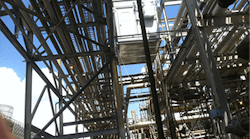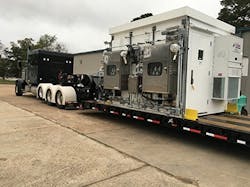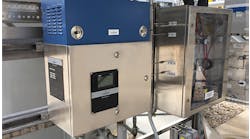Chemical plants often rely on process analyzers to meet environmental regulations, optimize their processes through online continuous monitoring and improve personnel safety. These analyzers typically reside in shelters located close to the processes and units being monitored. Frequently, operating companies opt to build these analyzer shelters onsite but this can be a time-consuming and expensive undertaking.
A better approach in many cases is buying a turnkey analyzer shelter with all analyzers, ancillary components and equipment installed and tested. Once delivered to the site and set in place, such a unit only requires connection to utilities and the processes. Large shelters with many analyzers and other complex requirements gain the most from offsite construction but smaller and simpler shelters also can benefit, especially when the necessary analyzer and assembly expertise isn’t available onsite. However, you must consider logistical and installation issues to decide if a turnkey approach is realistic.
Before getting into specific points about turnkey units, let’s first look at what an analyzer system consists of and how it’s designed, assembled and tested.
The Need For Shelters
Analyzer reliability and measurement precision often depend on stable climate conditions. In addition, not all analyzers are suited for installation in hazardous locations. A shelter (Figure 1) addresses these issues by offering a protected and climate-controlled environment. Warm climates require air conditioning systems, which may also provide shelter ventilation and purging. Cold climates need a forced-air heating system along with insulation. The bottles supplying gas to the analyzers may be mounted inside the shelter or in heated external cabinets. Larger installations sometimes use a split shelter, with one side for analyzers and the other for the sample gas conditioning system.
Figure 1. Analyzers usually must reside close to the monitored operation — and this dictates the shelter site.
Modern analyzers generate large amounts of data, requiring routing of discrete signal and networking wiring to common data junction boxes, sometimes with fiber optic patch panels for transmission of large amounts of data. These junction boxes and patch panels are typically mounted on the outside of a shelter.
Proper shelter design accounts for many factors including ambient conditions, corrosive atmosphere and regulatory requirements as well as weight and size considerations. The shelter must maximize accessibility while minimizing costs and should provide space for growth and maintainability.
Sample systems are an integral part of a shelter design and require custom engineering for each application. Rain shields are strongly recommended to cover external portions of sample systems and bottles for protection against ultraviolet light and weather.
The interior atmosphere of a shelter often requires monitoring to detect the presence of hazardous gases using combustible analyzers, toxic gas (H2S, etc.) sensors and oxygen deficiency analyzers (common when analyzers use nitrogen). These detectors typically activate local warning lights and horns, and also send a signal to the plant’s main control room. Emergency ventilation sometimes is necessary for a toxic or O2 deficiency event, along with shutoff of the sample system.
A shelter typically requires a supply of power and, in some cases, an uninterruptible power system. In addition, instrument air is necessary for the operation of some analyzers, such as gas chromatographs (GCs), and, in some cases, for purging analyzer enclosures. The shelter may also require nitrogen, steam and water, along with calibration and support gases such as burner or actuation air, flush nitrogen and vortex coolant air.
Header and manifold systems simplify plumbing throughout the shelter for shared gases, instrument air, steam and GC carrier gases. Waste recovery headers handle venting of gases, with check valves provided if vents tie into plant processes such as flare gas systems. Similarly, a shelter sometimes needs a liquid recovery system, consisting of a storage tank, return pump(s) and associated piping.
Analyzers may be wall or rack-mounted; sufficient space must be allowed between analyzers for wiring, plumbing and maintenance access.
Managing all these design details throughout an analyzer shelter project can pose difficulties due to the wide diversity of hardware suppliers. Factory acceptance tests may take place at the analyzer manufacturer, after installation or both.
Sample Systems
The sample handling system includes portions of the process itself, the sample extraction nozzle and probe, the sample transport system, the sample conditioning system, the fluid pathway through the analyzer and the sample disposal facilities.
Figure 2 depicts an installed analyzer shelter along with the main interfaces to plant processes and utilities. Samples extracted from the process and conditioned go to the analyzer, with exhaust effluent from the conditioning system returned to the process.
Figure 2. Elements include the instrument as well as a sample system and data communications.
Process gas sample streams may go to different analyzers, necessitating switching so each stream gets routed through the analyzer calibration system and then to the analyzer. Effluent exiting the analyzers returns to the process through the sample effluent disposal system.
Sample conditioning prepares the gas samples drawn from the process to ensure compatibility with analyzer requirements. The sample delivered to the analyzer must be representative of the process and provided to the analyzer on a timely basis. This is best accomplished by limiting the distance from the sample point to the analyzer and, if needed, by keeping the sample line at similar conditions to the process, for example by heat tracing the sample transport system.
You must control the sample pressure, temperature and flow rate to reduce particulates, comply with analyzer constraints and preserve the gas or liquid phase to prevent a mixed-phase sample from entering the analyzer.
You also, of course, must ensure sample systems are safe to operate and adhere to relevant codes and regulations. You must select materials for system components that are compatible with the process sample’s constituents, including materials that don’t allow reactions, permeation or absorption because these actions may change the sample composition and degrade system integrity.
Offsite Assembly Advantages
An analyzer shelter houses delicate instruments and demands great care during assembly. Fabricating the shelter offsite and then transporting it to a plant may offer significant benefits.
Fabrication requires many specialized tasks such as bending, routing and installation of tubing. Offsite facilities have design and installation specialists on hand who perform these tasks on a regular and routine basis, skills rarely found with general mechanical and electrical construction crews.
Offsite construction allows testing of analyzers as part of the entire assembly, instead of in isolation prior to shipment to the site. This can reveal issues at interfaces between the analyzers and other systems such as sample conditioning, stream switching and effluent disposal.
An offsite facility dedicated to designing and assembling analyzer shelters can work much more quickly and efficiently than general construction crews working on site. Site installation activities are limited to setting the shelter in place and making connections to the process, utilities and control systems.
Minimizing onsite construction activities provides time and money savings because it’s much simpler and easier to construct a shelter offsite than in a plant, especially if the work must be performed during normal operation. Even if onsite shelter assembly can take place during a shutdown, activities during these periods are always hectic, so it’s best to do as much work as possible early and offsite.
Moreover, minimizing onsite construction activities reduces the likelihood of incidents. It’s much safer to assemble a shelter offsite, particularly if the final installation area is classified as hazardous, often the case in chemical plants and facilities.
Offsite construction eases detection and resolution of any compatibility issues with analyzers from different suppliers. For example, some types of Ethernet-based outputs aren’t compatible.
Performing a thorough factory acceptance test offsite prior to delivery can address these and other issues. In some cases, such a test can include introducing sample gases, which might not be possible in an operating facility due to safety concerns in hazardous areas. Plant personnel can witness the test, allowing them to suggest changes and improvements.
Size Considerations
Offsite assembly and testing of a shelter isn’t always feasible, though. Analyzer shelters can be quite large (Figure 3), presenting a number of transport and installation problems and costs. Shipping restrictions and availability of a path to the installation point on the site may limit shelter size.
Figure 3. The cost and feasibility of transporting an analyzer shelter and installing it at the site can pose limitations.
Shipping restrictions vary from one locale to the next, with transport costs rising along with shelter size. For example, shelters wider than 12 feet may require escorted transportation, greatly increasing costs and adding to delivery time. Shipping can incur other substantial costs, including for any necessary shelter crating. Overseas shipping may be prohibitive in terms of time and money because it involves transport to a dock, loading onto a ship, transport on the ship, unloading at a dock and transport from the dock to the plant.
A shelter arriving at a plant requires a clear path from the receiving location to the installation point. Typically, a shelter is trucked to a location near the installation point, then lifted by a crane and set in place. This last step isn’t always practical due to the presence of overhead obstructions; it also may be cost prohibitive, particularly if the crane lift has to span a long distance or excessive height.
Finally, shipping and installation always pose the potential risk of damage. Insurance may cover the cost of damage but rarely the costs incurred by a delayed schedule, which can be substantial.
Consider Both Options
Analyzer shelters are complex to design, construct and test. They require many different construction trades, along with a high level of technical expertise for testing and other activities. If shipping and installation is possible and not cost prohibitive, offsite shelter construction often makes the most sense.
You should evaluate both approaches in all instances. Pay particular attention to the expertise and experience of the offsite construction vendor, especially with respect to the goals of the intended application. It’s best to visit the vendor’s facility as well as to obtain detailed information and references for similar projects performed for other chemical companies. It’s always a good idea to contact these customers to evaluate vendor performance and gather information to improve design, construction, test and installation activities.
JOE GOH is a product manager for Yokogawa Corp. of America, Coldspring, Texas. Email him at [email protected].




